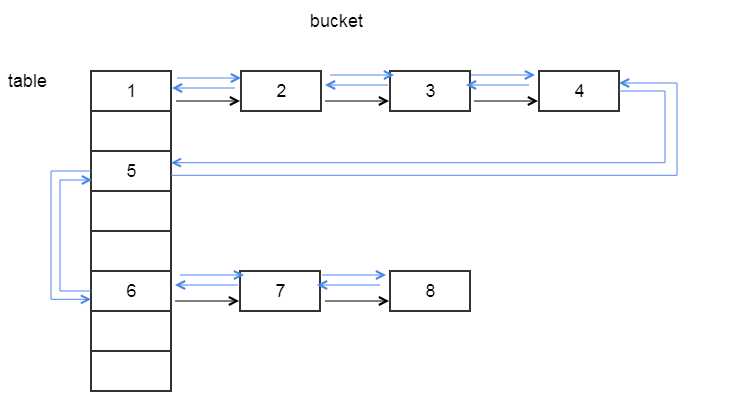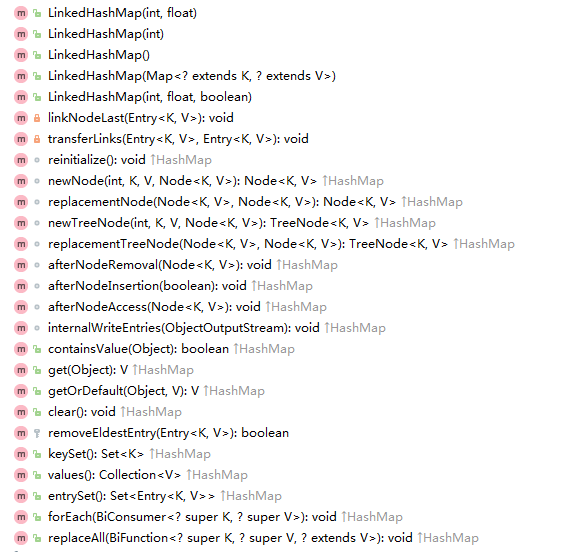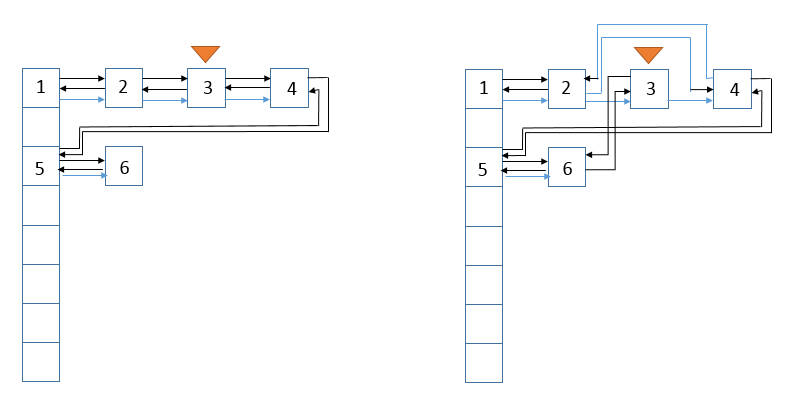集合之LinkedHashMap(含JDK1.8源码分析)
一、前言
大多数的情况下,只要不涉及线程安全问题,map都可以使用hashMap,不过hashMap有一个问题,hashMap的迭代顺序不是hashMap的存储顺序,即hashMap中的元素是无序的。但是有些场景下,我们需要使用一个有序的map。这种情况下,我们就需要使用linkedHashMap,它虽然增加了时间和空间上的开销,但是通过维护一个运行于所有条目的双向链表,linkedHashMap保证了元素的迭代顺序。
四个关注点在linkedHashMap上的答案

二、linkedHashMap的数据结构

说明:上图说明了linkedHashMap的数据结构,和hashMap一样,linkedHashMap也使用了数组+链表(单向链表)+红黑树的方式来存储元素,所不同的是,因为需要维护元素的存储顺序,linkedHashMap还使用了双向链表来将前后元素串起来。所以linkedHashMap的数据结构为:数组+单向链表+红黑树+双向链表。
三、linkedHashMap源码分析-属性及构造函数
3.1 类的继承关系
public class LinkedHashMap<K,V>extends HashMap<K,V>implements Map<K,V>
说明:linkedHashMap继承自hashMap,所以hashMap中非私有的属性和方法,linkedHashMap都可以使用,而且从下图linkedHashMap的方法中可以看出,linkedHashMap中并没有直接操作数据结构的方法(比如对元素的增删改查的函数,除了get函数),其对元素的增删改查等操作都是基于其父类hashMap中的方法,所不同的只是细节上的实现有所区别罢了。
linkedHashMap中的方法:

3.2 类的属性
public class LinkedHashMap<K,V> extends HashMap<K,V> implements Map<K,V> {
static class Entry<K,V> extends HashMap.Node<K,V> {
Entry<K,V> before, after;
Entry(int hash, K key, V value, Node<K,V> next) {
super(hash, key, value, next);
}
}
// 版本序列号
private static final long serialVersionUID = 3801124242820219131L;
// 链表头结点
transient LinkedHashMap.Entry<K,V> head;
// 链表尾结点
transient LinkedHashMap.Entry<K,V> tail;
// 访问顺序
final boolean accessOrder;
}
说明:其中静态内部类Entry就是存储元素的地方,类似于hashMap中的Node,只是多了个before,after属性用于维护双向链表。accessOrder为true的时候,linkedHashMap中的元素是以访问的顺序存储,accessOrder为false的时候,linkedHashMap中的元素是以插入的顺序存储,一般我们使用的都是accessOrder为false的情况,即元素以插入的顺序排序,关于accessOrder为true的用法下面会提到。
3.3 类的构造函数
1、LinkedHashMap(int initialCapacity, float loadFactor)型
/**
* Constructs an empty insertion-ordered <tt>LinkedHashMap</tt> instance
* with the specified initial capacity and load factor.
*
* @param initialCapacity the initial capacity
* @param loadFactor the load factor
* @throws IllegalArgumentException if the initial capacity is negative
* or the load factor is nonpositive
*/
public LinkedHashMap(int initialCapacity, float loadFactor) {
super(initialCapacity, loadFactor);
accessOrder = false;
}
说明:调用父类hashMap中对应的构造方法,并将accessOrder置为false,通过指定的初始容量和加载因子实例化一个空的、以插入顺序来存储的linkedHashMap。
2、LinkedHashMap(int initialCapacity)型
/**
* Constructs an empty insertion-ordered <tt>LinkedHashMap</tt> instance
* with the specified initial capacity and a default load factor (0.75).
*
* @param initialCapacity the initial capacity
* @throws IllegalArgumentException if the initial capacity is negative
*/
public LinkedHashMap(int initialCapacity) {
super(initialCapacity);
accessOrder = false;
}
说明:调用父类hashMap中对应的构造方法,并将accessOrder置为false,通过指定的初始容量和默认的加载因子实例化一个空的、以插入顺序来存储的linkedHashMap。
3、LinkedHashMap()型
/**
* Constructs an empty insertion-ordered <tt>LinkedHashMap</tt> instance
* with the default initial capacity (16) and load factor (0.75).
*/
public LinkedHashMap() {
super();
accessOrder = false;
}
说明:调用父类hashMap中对应的构造方法,并将accessOrder置为false,通过默认的初始容量和加载因子实例化一个空的、以插入顺序来存储的linkedHashMap。
4、LinkedHashMap(Map<? extends K, ? extends V> m)型
/**
* Constructs an insertion-ordered <tt>LinkedHashMap</tt> instance with
* the same mappings as the specified map. The <tt>LinkedHashMap</tt>
* instance is created with a default load factor (0.75) and an initial
* capacity sufficient to hold the mappings in the specified map.
*
* @param m the map whose mappings are to be placed in this map
* @throws NullPointerException if the specified map is null
*/
public LinkedHashMap(Map<? extends K, ? extends V> m) {
super();
accessOrder = false;
putMapEntries(m, false);
}
说明:调用父类hashMap中对应的构造方法,并将accessOrder置为false,通过默认的初始容量和加载因子实例化一个以插入顺序来存储的linkedHashMap(已存储参数map中的元素)。
5、LinkedHashMap(int initialCapacity, float loadFactor, boolean accessOrder)型
/**
* Constructs an empty <tt>LinkedHashMap</tt> instance with the
* specified initial capacity, load factor and ordering mode.
*
* @param initialCapacity the initial capacity
* @param loadFactor the load factor
* @param accessOrder the ordering mode - <tt>true</tt> for
* access-order, <tt>false</tt> for insertion-order
* @throws IllegalArgumentException if the initial capacity is negative
* or the load factor is nonpositive
*/
public LinkedHashMap(int initialCapacity,
float loadFactor,
boolean accessOrder) {
super(initialCapacity, loadFactor);
this.accessOrder = accessOrder;
}
说明:调用父类hashMap中对应的构造方法,并将accessOrder置为true或false,通过指定的初始容量、指定的加载因子、指定的accessOrder实例化一个空的linkedHashMap。
四、linkedHashMap源码分析-核心函数
linkedHashMap对元素的增删改查等操作大多基于其父类hashMap中的方法,只是实现的细节有所不同,而linkedHashMap所做的是维护元素的插入顺序(双向链表)。
4.1 增:put和putVal函数----存储元素
所使用的是hashMap中的put和putVal函数
/**
* Associates the specified value with the specified key in this map.
* If the map previously contained a mapping for the key, the old
* value is replaced.
*
* @param key key with which the specified value is to be associated
* @param value value to be associated with the specified key
* @return the previous value associated with <tt>key</tt>, or
* <tt>null</tt> if there was no mapping for <tt>key</tt>.
* (A <tt>null</tt> return can also indicate that the map
* previously associated <tt>null</tt> with <tt>key</tt>.)
*/
public V put(K key, V value) {
return putVal(hash(key), key, value, false, true);
}
但是在putVal中的实现有所不同
/**
* Implements Map.put and related methods
*
* @param hash hash for key
* @param key the key
* @param value the value to put
* @param onlyIfAbsent if true, don't change existing value
* @param evict if false, the table is in creation mode.
* @return previous value, or null if none
*/
final V putVal(int hash, K key, V value, boolean onlyIfAbsent,
boolean evict) {
Node<K,V>[] tab; Node<K,V> p; int n, i;
if ((tab = table) == null || (n = tab.length) == 0)
n = (tab = resize()).length;
if ((p = tab[i = (n - 1) & hash]) == null)
tab[i] = newNode(hash, key, value, null);
else {
Node<K,V> e; K k;
if (p.hash == hash &&
((k = p.key) == key || (key != null && key.equals(k))))
e = p;
else if (p instanceof TreeNode)
e = ((TreeNode<K,V>)p).putTreeVal(this, tab, hash, key, value);
else {
for (int binCount = 0; ; ++binCount) {
if ((e = p.next) == null) {
p.next = newNode(hash, key, value, null);
if (binCount >= TREEIFY_THRESHOLD - 1) // -1 for 1st
treeifyBin(tab, hash);
break;
}
if (e.hash == hash &&
((k = e.key) == key || (key != null && key.equals(k))))
break;
p = e;
}
}
if (e != null) { // existing mapping for key
V oldValue = e.value;
if (!onlyIfAbsent || oldValue == null)
e.value = value;
afterNodeAccess(e);
return oldValue;
}
}
++modCount;
if (++size > threshold)
resize();
afterNodeInsertion(evict);
return null;
}
说明1:注意位于第17、28行的newNode方法,因为linkedHashMap中重写了这个方法,所以在虽然存储元素用的是hashMap中的putVal方法,但到newNode时调用的是linkedHashMap的newNode方法,这是多态的概念。
linkedHashMap中的newNode方法:
Node<K,V> newNode(int hash, K key, V value, Node<K,V> e) {
LinkedHashMap.Entry<K,V> p =
new LinkedHashMap.Entry<K,V>(hash, key, value, e);
linkNodeLast(p);
return p;
}
linkNodeLast方法:维护确保元素存储顺序的双向链表:
// link at the end of list
private void linkNodeLast(LinkedHashMap.Entry<K,V> p) {
LinkedHashMap.Entry<K,V> last = tail;
tail = p;
if (last == null)
head = p;
else {
p.before = last;
last.after = p;
}
}
其中LinkedHashMap.Entry继承自HashMap.Node,在HashMap.Node基础上增加了前后两个指针域,注意,HashMap.Node中的next域也存在。
/**
* HashMap.Node subclass for normal LinkedHashMap entries.
*/
static class Entry<K,V> extends HashMap.Node<K,V> {
Entry<K,V> before, after;
Entry(int hash, K key, V value, Node<K,V> next) {
super(hash, key, value, next);
}
}
同理,newTreeNode也一样,调用的是linkedHashMap中的newTreeNode方法
TreeNode<K,V> newTreeNode(int hash, K key, V value, Node<K,V> next) {
TreeNode<K,V> p = new TreeNode<K,V>(hash, key, value, next);
linkNodeLast(p);
return p;
}
说明2:注意位于第43、50行的afterNodeAccess和afterNodeInsertion,因为linkedHashMap中重写了这两个方法,所以实际中调动的是linkedHashMap中的这两个方法,和上述的newNode一样,也是多态的概念。
afterNodeAccess:
void afterNodeAccess(Node<K,V> e) { // move node to last
LinkedHashMap.Entry<K,V> last;
if (accessOrder && (last = tail) != e) {
LinkedHashMap.Entry<K,V> p =
(LinkedHashMap.Entry<K,V>)e, b = p.before, a = p.after;
p.after = null;
if (b == null)
head = a;
else
b.after = a;
if (a != null)
a.before = b;
else
last = b;
if (last == null)
head = p;
else {
p.before = last;
last.after = p;
}
tail = p;
++modCount;
}
}
说明:此函数在很多函数(如put)中都会被回调,若访问顺序为true,且访问的对象不是尾结点,则下面的图展示了访问前和访问后的状态,假设访问的结点为结点3

说明:从图中可以看到,结点3链接到了双向链表原尾结点后面,变成了新的尾节点。
afterNodeInsertion:
void afterNodeInsertion(boolean evict) { // possibly remove eldest
LinkedHashMap.Entry<K,V> first;
if (evict && (first = head) != null && removeEldestEntry(first)) {
K key = first.key;
removeNode(hash(key), key, null, false, true);
}
}
removeEldestEntry:
/**
* Returns <tt>true</tt> if this map should remove its eldest entry.
* This method is invoked by <tt>put</tt> and <tt>putAll</tt> after
* inserting a new entry into the map. It provides the implementor
* with the opportunity to remove the eldest entry each time a new one
* is added. This is useful if the map represents a cache: it allows
* the map to reduce memory consumption by deleting stale entries.
*
* <p>Sample use: this override will allow the map to grow up to 100
* entries and then delete the eldest entry each time a new entry is
* added, maintaining a steady state of 100 entries.
* <pre>
* private static final int MAX_ENTRIES = 100;
*
* protected boolean removeEldestEntry(Map.Entry eldest) {
* return size() > MAX_ENTRIES;
* }
* </pre>
*
* <p>This method typically does not modify the map in any way,
* instead allowing the map to modify itself as directed by its
* return value. It <i>is</i> permitted for this method to modify
* the map directly, but if it does so, it <i>must</i> return
* <tt>false</tt> (indicating that the map should not attempt any
* further modification). The effects of returning <tt>true</tt>
* after modifying the map from within this method are unspecified.
*
* <p>This implementation merely returns <tt>false</tt> (so that this
* map acts like a normal map - the eldest element is never removed).
*
* @param eldest The least recently inserted entry in the map, or if
* this is an access-ordered map, the least recently accessed
* entry. This is the entry that will be removed it this
* method returns <tt>true</tt>. If the map was empty prior
* to the <tt>put</tt> or <tt>putAll</tt> invocation resulting
* in this invocation, this will be the entry that was just
* inserted; in other words, if the map contains a single
* entry, the eldest entry is also the newest.
* @return <tt>true</tt> if the eldest entry should be removed
* from the map; <tt>false</tt> if it should be retained.
*/
protected boolean removeEldestEntry(Map.Entry<K,V> eldest) {
return false;
}
说一下这个方法的使用:
afterNodeInsertion方法会在使用put和putAll方法的时候被调用。返回true会删除map中的eldest entry(accessOrder为false:least recently inserted entry,accessOrder为true:least recently accessed entry),返回false不做任何操作。
该方法给其子类定义了一个功能:返回true,每次有元素被added的时候,都会remove the eldest entry。这在linkedHashMap被用作缓存的时候是有用的,可以减少内存的消耗,不会无限制的存储元素。
注释中也给了一个linkedHashMap用作缓存的例子:linkedHashMap只存储100个元素,当超过100个元素的时候,就会进行remove。
无特别定义的情况下,afterNodeAccess(accessOrder为true)和afterNodeInsertion(重写该方法,返回true值)都不会执行里面的操作。所以linkedHashMap中存储元素时和hashMap是一样的,只是多了一个维护元素顺序的双向链表。
4.2 删:remove和removeNode函数----删除元素
所使用的是hashMap中的remove和removeNode函数
/**
* Removes the mapping for the specified key from this map if present.
*
* @param key key whose mapping is to be removed from the map
* @return the previous value associated with <tt>key</tt>, or
* <tt>null</tt> if there was no mapping for <tt>key</tt>.
* (A <tt>null</tt> return can also indicate that the map
* previously associated <tt>null</tt> with <tt>key</tt>.)
*/
public V remove(Object key) {
Node<K,V> e;
return (e = removeNode(hash(key), key, null, false, true)) == null ?
null : e.value;
}
removeNode方法
/**
* Implements Map.remove and related methods
*
* @param hash hash for key
* @param key the key
* @param value the value to match if matchValue, else ignored
* @param matchValue if true only remove if value is equal
* @param movable if false do not move other nodes while removing
* @return the node, or null if none
*/
final Node<K,V> removeNode(int hash, Object key, Object value,
boolean matchValue, boolean movable) {
Node<K,V>[] tab; Node<K,V> p; int n, index;
if ((tab = table) != null && (n = tab.length) > 0 &&
(p = tab[index = (n - 1) & hash]) != null) {
Node<K,V> node = null, e; K k; V v;
if (p.hash == hash &&
((k = p.key) == key || (key != null && key.equals(k))))
node = p;
else if ((e = p.next) != null) {
if (p instanceof TreeNode)
node = ((TreeNode<K,V>)p).getTreeNode(hash, key);
else {
do {
if (e.hash == hash &&
((k = e.key) == key ||
(key != null && key.equals(k)))) {
node = e;
break;
}
p = e;
} while ((e = e.next) != null);
}
}
if (node != null && (!matchValue || (v = node.value) == value ||
(value != null && value.equals(v)))) {
if (node instanceof TreeNode)
((TreeNode<K,V>)node).removeTreeNode(this, tab, movable);
else if (node == p)
tab[index] = node.next;
else
p.next = node.next;
++modCount;
--size;
afterNodeRemoval(node);
return node;
}
}
return null;
}
注意第45行的afterNodeRemoval方法,该方法在linkedHashMap中被重写,所以实际调用的是linkedHashMap中的afterNodeRemoval方法
void afterNodeRemoval(Node<K,V> e) { // unlink
LinkedHashMap.Entry<K,V> p =
(LinkedHashMap.Entry<K,V>)e, b = p.before, a = p.after;
p.before = p.after = null;
if (b == null)
head = a;
else
b.after = a;
if (a == null)
tail = b;
else
a.before = b;
}
说明:该方法就是重新维护双向链表中元素的前后联系。
4.3 改:putVal函数----修改元素
详见4.1,与添加元素是同一个操作。
4.4 查:get和getNode方法----查找元素
linkedHashMap中重写了get方法,但其中的getNod方法使用的还是hashMap中的getNode方法
/**
* Returns the value to which the specified key is mapped,
* or {@code null} if this map contains no mapping for the key.
*
* <p>More formally, if this map contains a mapping from a key
* {@code k} to a value {@code v} such that {@code (key==null ? k==null :
* key.equals(k))}, then this method returns {@code v}; otherwise
* it returns {@code null}. (There can be at most one such mapping.)
*
* <p>A return value of {@code null} does not <i>necessarily</i>
* indicate that the map contains no mapping for the key; it's also
* possible that the map explicitly maps the key to {@code null}.
* The {@link #containsKey containsKey} operation may be used to
* distinguish these two cases.
*/
public V get(Object key) {
Node<K,V> e;
if ((e = getNode(hash(key), key)) == null)
return null;
if (accessOrder)
afterNodeAccess(e);
return e.value;
}
与hashMap中的get方法不同的是,linkedHashMap中根据accessOrder的真假来调用afterNodeAccess方法,为true,get查询元素的时候就会重新进行双向链表的维护,将最近一次访问的元素置于双向链表的尾部,为false,不做下一步操作。参见4.1中的afterNodeAccess方法。
举例(accessOrder为true):
public class Test {
public static void main(String[] args) {
LinkedHashMap<String,String> linkedHashMap = new LinkedHashMap<>(16,0.75f,true);
linkedHashMap.put("111","111");
linkedHashMap.put("222","222");
linkedHashMap.put("333","333");
linkedHashMap.put("444","444");
System.out.println("未进行访问之前=========" + linkedHashMap);
linkedHashMap.get("222");
System.out.println("进行访问之后===========" + linkedHashMap);
}
}
结果:
未进行访问之前========={111=111, 222=222, 333=333, 444=444}
进行访问之后==========={111=111, 333=333, 444=444, 222=222}
4.5 containsValue函数----map是否存在该value
/**
* Returns <tt>true</tt> if this map maps one or more keys to the
* specified value.
*
* @param value value whose presence in this map is to be tested
* @return <tt>true</tt> if this map maps one or more keys to the
* specified value
*/
public boolean containsValue(Object value) {
for (LinkedHashMap.Entry<K,V> e = head; e != null; e = e.after) {
V v = e.value;
if (v == value || (value != null && value.equals(v)))
return true;
}
return false;
}
说明:containsValue函数根据双链表结构来查找是否包含value,是按照插入顺序进行查找的,与HashMap中的此函数查找方式不同,HashMap是使用按照桶遍历,没有考虑插入顺序。
hashMap中的containsValue函数
/**
* Returns <tt>true</tt> if this map maps one or more keys to the
* specified value.
*
* @param value value whose presence in this map is to be tested
* @return <tt>true</tt> if this map maps one or more keys to the
* specified value
*/
public boolean containsValue(Object value) {
Node<K,V>[] tab; V v;
if ((tab = table) != null && size > 0) {
for (int i = 0; i < tab.length; ++i) {
for (Node<K,V> e = tab[i]; e != null; e = e.next) {
if ((v = e.value) == value ||
(value != null && value.equals(v)))
return true;
}
}
}
return false;
}
五、总结
总得来看,LinkedHashMap的实现就是HashMap+LinkedList的实现方式,以HashMap维护数据结构,以LinkList的方式维护数据插入顺序。
最后说一下利用linkedHashMap实现LRUCache(LRU算法缓存)
LRUCache源码如下:
public class LRUCache<K, V> extends LinkedHashMap<K, V> {
private static final long serialVersionUID = 1L;
private final int maxSize;
public LRUCache(int maxSize){
this(maxSize, 16, 0.75f, false);
}
public LRUCache(int maxSize, int initialCapacity, float loadFactor, boolean accessOrder){
super(initialCapacity, loadFactor, accessOrder);
this.maxSize = maxSize;
}
protected boolean removeEldestEntry(Map.Entry<K, V> eldest) {
return this.size() > this.maxSize;
}
}
顾名思义,LRUCache就是基于LRU算法的Cache(缓存),这个类继承自LinkedHashMap,而类中看到没有什么特别的方法,这说明LRUCache实现缓存功能都是源自LinkedHashMap的。LinkedHashMap可以实现LRU算法的缓存基于两点:
1、LinkedList首先它是一个Map,Map是基于K-V的,和缓存一致
2、LinkedList提供了一个boolean值可以让用户指定是否实现LRU
那么,首先我们了解一下什么是LRU:LRU即Least Recently Used,最近最少使用,也就是说,当缓存满了,会优先淘汰那些最近最不常访问的数据。比方说数据a,1天前访问了;数据b,2天前访问了,缓存满了,优先会淘汰数据b。
上述linkedHashMap的构造函数中有个带布尔值的:
public LinkedHashMap(int initialCapacity,
float loadFactor,
boolean accessOrder) {
super(initialCapacity, loadFactor);
this.accessOrder = accessOrder;
}
这个accessOrder,它表示:
(1)false,所有的Entry按照插入的顺序排列
(2)true,所有的Entry按照访问的顺序排列
第二点的意思就是,如果有1 2 3这3个Entry,那么访问了1,就把1移到尾部去,即2 3 1。每次访问都把访问的那个数据移到双向队列的尾部去,那么每次要淘汰数据的时候,双向队列最头的那个数据不就是最不常访问的那个数据了吗?换句话说,双向链表最头的那个数据就是要淘汰的数据。
"访问",这个词有两层意思:
1、根据Key拿到Value,也就是get方法
2、修改Key对应的Value,也就是put方法
根据linkedHashMap的源码也可以看到,在调用get方法和put方法的时候,都会调用afterNodeAccess方法,accessOrder为true就会重新进行元素的排序。
至于如何淘汰掉最近最少使用的元素,当我们在linkedHashMap中增加元素(put)的时候,都会调用afterNodeInsertion函数,当我们重写afterNodeInsertion函数中的removeEldestEntry函数并返回true时,就会进行删除最近最少使用的元素了。
举例说明:
public class LRULinkedHashMap {
//定义缓存的容量
private int cacheSize;
private LinkedHashMap<String,String> cacheMap;
public LRULinkedHashMap(int cacheSize){
this.cacheSize = cacheSize;
cacheMap = new LinkedHashMap(16, 0.75F, true){
//重写linkedHashMap中的removeEldestEntry方法,
@Override
protected boolean removeEldestEntry(Map.Entry eldest) {
//当linkedHashMap中元素的个数大于缓存的个数时,返回true,删除最近最少使用的元素
if(cacheMap.size() > cacheSize){
return true;
}else{
return false;
}
}
};
}
public void put(String key, String value){
cacheMap.put(key, value);
}
public String get(String key){
return cacheMap.get(key);
}
public Set<Map.Entry<String, String>> getAll(){
return cacheMap.entrySet();
}
public static void main(String[] args) {
LRULinkedHashMap map = new LRULinkedHashMap(3);
map.put("key1", "1");
map.put("key2", "2");
map.put("key3", "3");
for (Map.Entry<String, String> e : map.getAll()){
System.out.println(e.getKey()+"====>"+e.getValue());
}
System.out.println("\n");
map.get("key2");
for (Map.Entry<String, String> e : map.getAll()){
System.out.println(e.getKey()+"====>"+e.getValue());
}
System.out.println("\n");
map.put("key4", "4");
for (Map.Entry<String, String> e : map.getAll()){
System.out.println(e.getKey()+"====>"+e.getValue());
}
}
}
结果:
key1====>1
key2====>2
key3====>3 key1====>1
key3====>3
key2====>2 key3====>3
key2====>2
key4====>4
说明:自定义一个基于linkedHashMap实现的缓存类,缓存容量为3,当添加了三个元素后进行get访问,再put第四个元素,根据结果来看,符合上面的分析。
参考:
https://www.cnblogs.com/xrq730/p/5052323.html
https://www.cnblogs.com/leesf456/p/5248868.html
集合之LinkedHashMap(含JDK1.8源码分析)的更多相关文章
- 集合之LinkedHashSet(含JDK1.8源码分析)
一.前言 上篇已经分析了Set接口下HashSet,我们发现其操作都是基于hashMap的,接下来看LinkedHashSet,其底层实现都是基于linkedHashMap的. 二.linkedHas ...
- 集合之HashSet(含JDK1.8源码分析)
一.前言 我们已经分析了List接口下的ArrayList和LinkedList,以及Map接口下的HashMap.LinkedHashMap.TreeMap,接下来看的是Set接口下HashSet和 ...
- 集合之TreeSet(含JDK1.8源码分析)
一.前言 前面分析了Set接口下的hashSet和linkedHashSet,下面接着来看treeSet,treeSet的底层实现是基于treeMap的. 四个关注点在treeSet上的答案 二.tr ...
- 集合之TreeMap(含JDK1.8源码分析)
一.前言 前面所说的hashMap和linkedHashMap都不具备统计的功能,或者说它们的统计性能的时间复杂度都不是很好,要想对两者进行统计,需要遍历所有的entry,时间复杂度比较高,此时,我们 ...
- 集合之HashMap(含JDK1.8源码分析)
一.前言 之前的List,讲了ArrayList.LinkedList,反映的是两种思想: (1)ArrayList以数组形式实现,顺序插入.查找快,插入.删除较慢 (2)LinkedList以链表形 ...
- 集合之LinkedList(含JDK1.8源码分析)
一.前言 LinkedList是基于链表实现的,所以先讲解一下什么是链表.链表原先是C/C++的概念,是一种线性的存储结构,意思是将要存储的数据存在一个存储单元里面,这个存储单元里面除了存放有待存储的 ...
- 集合之ArrayList(含JDK1.8源码分析)
一.ArrayList的数据结构 ArrayList底层的数据结构就是数组,数组元素类型为Object类型,即可以存放所有类型数据.我们对ArrayList类的实例的所有的操作(增删改查等),其底层都 ...
- 【集合框架】JDK1.8源码分析HashSet && LinkedHashSet(八)
一.前言 分析完了List的两个主要类之后,我们来分析Set接口下的类,HashSet和LinkedHashSet,其实,在分析完HashMap与LinkedHashMap之后,再来分析HashSet ...
- 【集合框架】JDK1.8源码分析之HashMap(一) 转载
[集合框架]JDK1.8源码分析之HashMap(一) 一.前言 在分析jdk1.8后的HashMap源码时,发现网上好多分析都是基于之前的jdk,而Java8的HashMap对之前做了较大的优化 ...
随机推荐
- 003_生成器(generator)内部解析
#http://kb.cnblogs.com/page/87128/(未看完)
- (4)HomeAssistant 语言控制
中文教程:https://www.hachina.io/docs/2073.html 英文网教程:https://www.home-assistant.io/components/conversati ...
- Consumer group理解深入
每一个consumer实例都属于一个consumer group,每一条消息只会被同一个consumer group里的一个consumer实例消费.(不同consumer group可以同时消费同一 ...
- Eclipse下关于The serializable class UsersServlet does not declare a static final serialVersionUID field of type的警告
The serializable class XXX does not declare a static final serialVersionUID field of type long seria ...
- [MicroPython]TurniBit开发板旋转按钮控制脱机摆动
一.实验目的: ?学习在PC机系统中扩展简单I/O 接口的方法 ?学习TurnipBit拼插编程 ?了解舵机工作原理 ?学习TurnipBit扩展板舵机和旋转按钮接线方式 二.所需原器件: ?Turn ...
- linux日志:syslogd和klogd及syslog
一. 日志守护进程 syslogd和klogd是很有意思的守护进程,syslogd是一个分发器,它将接收到的所有日志按照/etc/syslog.conf的配置策略发送到这些日志应该去的地方,当然也包括 ...
- Feature Extractor[VGG]
0. 背景 Karen Simonyan等人在2014年参加Imagenet挑战赛的时候提出的深度卷积神经网络.作者通过对2013年的ILSVRC中最好的深度神经网络模型(他们最初的对应模型都是ale ...
- RabbitMQ详解(三)------RabbitMQ的五种队列
上一篇博客我们介绍了RabbitMQ消息通信中的一些基本概念,这篇博客我们介绍 RabbitMQ 的五种工作模式,这也是实际使用RabbitMQ需要重点关注的. 这里是RabbitMQ 官网中的相关介 ...
- 01-认识Jenkins
1.1 Jenkins是什么? Jenkins官网: http://jenkins.io/ .Jenkins前身是Hudson,使用java语言开发的自动化发布工具.在中大型金融等企业中普遍使用Jen ...
- 【转】AlphaGO Zero 原理
原文地址:https://www.hhyz.me/2018/08/08/2018-08-08-AlphaGO-Zero/> 1. 概述 简单来说,AlphaGo Zero 的训练可以分为三个 ...
